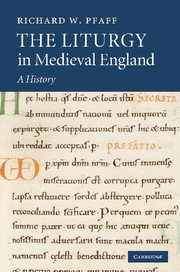Book contents
- Frontmatter
- Contents
- Preface
- Sigla and editorial conventions
- Bibliographical abbreviations
- Nicknames for manuscripts frequently referred to
- 1 Introduction
- Excursus: on sources
- 2 Early Anglo-Saxon England: a partly traceable story
- Excursus: on the terms Gregorian and Gelasian as used here
- 3 Later Anglo-Saxon: liturgy for England
- 4 The Norman Conquest: cross fertilizations
- Excursus: on method in the comparison of liturgical texts
- 5 Monastic liturgy, 1100–1215
- Excursus: on ascription of liturgical books to specific churches
- 6 Benedictine liturgy after 1215
- 7 Other monastic orders
- 8 The non-monastic religious orders: canons regular
- 9 The non-monastic religious orders: friars
- Excursus: on liturgical books from female religious houses
- 10 Old Sarum: the beginnings of Sarum Use
- 11 New Sarum and the spread of Sarum Use
- 12 Exeter: the fullness of secular liturgy
- 13 Southern England: final Sarum Use
- 14 Regional Uses and local variety
- 15 Towards the end of the story
- Index of Manuscripts
- Index of Saints
- General Index
3 - Later Anglo-Saxon: liturgy for England
Published online by Cambridge University Press: 20 March 2010
- Frontmatter
- Contents
- Preface
- Sigla and editorial conventions
- Bibliographical abbreviations
- Nicknames for manuscripts frequently referred to
- 1 Introduction
- Excursus: on sources
- 2 Early Anglo-Saxon England: a partly traceable story
- Excursus: on the terms Gregorian and Gelasian as used here
- 3 Later Anglo-Saxon: liturgy for England
- 4 The Norman Conquest: cross fertilizations
- Excursus: on method in the comparison of liturgical texts
- 5 Monastic liturgy, 1100–1215
- Excursus: on ascription of liturgical books to specific churches
- 6 Benedictine liturgy after 1215
- 7 Other monastic orders
- 8 The non-monastic religious orders: canons regular
- 9 The non-monastic religious orders: friars
- Excursus: on liturgical books from female religious houses
- 10 Old Sarum: the beginnings of Sarum Use
- 11 New Sarum and the spread of Sarum Use
- 12 Exeter: the fullness of secular liturgy
- 13 Southern England: final Sarum Use
- 14 Regional Uses and local variety
- 15 Towards the end of the story
- Index of Manuscripts
- Index of Saints
- General Index
Summary
The working definition of “Later Anglo-Saxon” used here stops for most purposes in about 1050, despite the now widely-accepted periodization that extends it to as late as 1100. Although the year 1066 is for us by no means without significance (clearly much in the way of decisive change begins because of the outcome of the battle of Hastings), to posit a clear break then would be specious; but extending the period under consideration here to the end of the century risks being too broad. Certain topics, most notably the work of Lanfranc and the fresh start made possible by the move of the west-Wessex cathedral site from Sherborne to (Old) Sarum around 1075, must sensibly be treated in chapters devoted to matters sequential to the Norman Conquest. In general, evidence from the fourth, and even third, quarter of the eleventh century – of which there is quite a lot, above all for the liturgical program of Leofric of Exeter – will be treated later. The present chapter will concentrate only on matters that may contribute to our understanding of the liturgy in what is clearly “pre-Conquest” England.
At the beginning of the period the picture of that liturgy is at best sketchy. The generalization that we have, as near as makes no difference, no knowledge of organized monastic life for men in the two or three decades on either side of the year 900, though much shaken by recent scholarship, still applies as regards the liturgy, and information about such women's houses as we have is tantalizing rather than conclusive.
- Type
- Chapter
- Information
- The Liturgy in Medieval EnglandA History, pp. 62 - 100Publisher: Cambridge University PressPrint publication year: 2009
- 2
- Cited by



